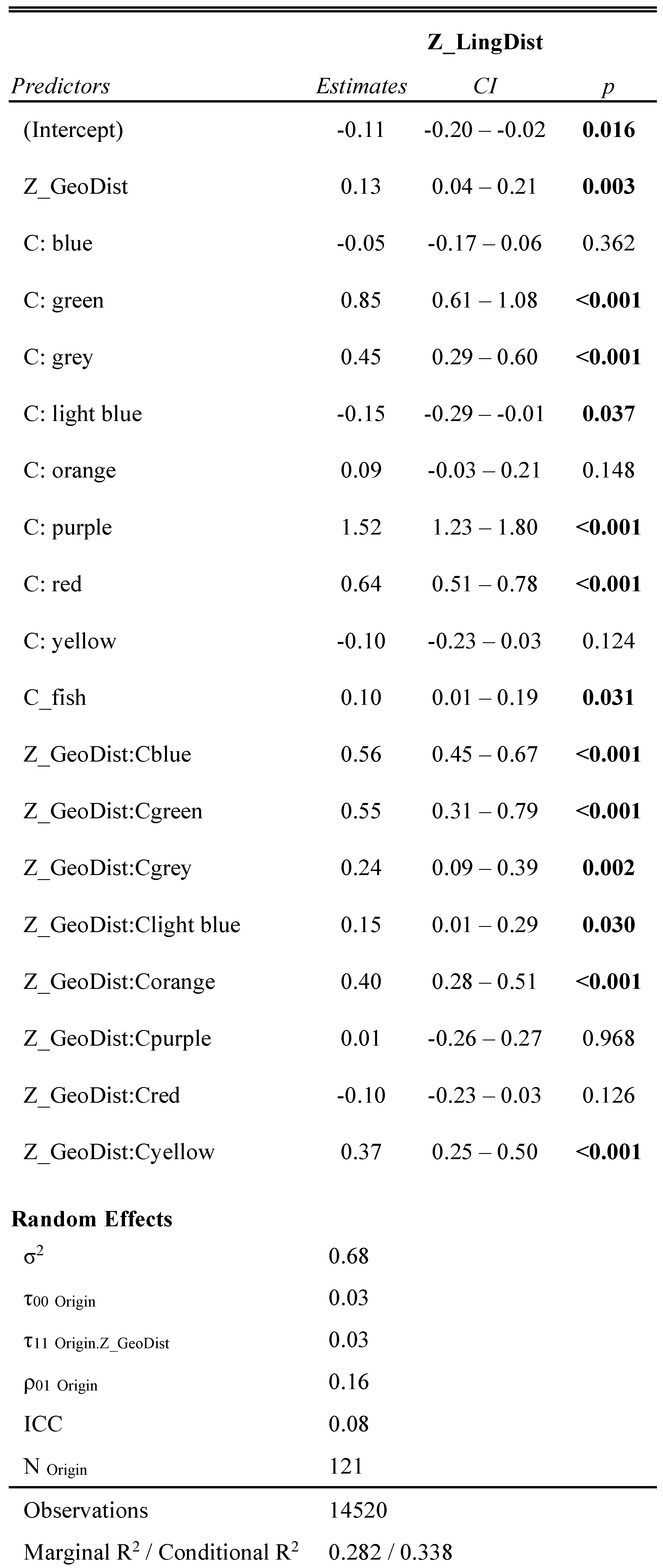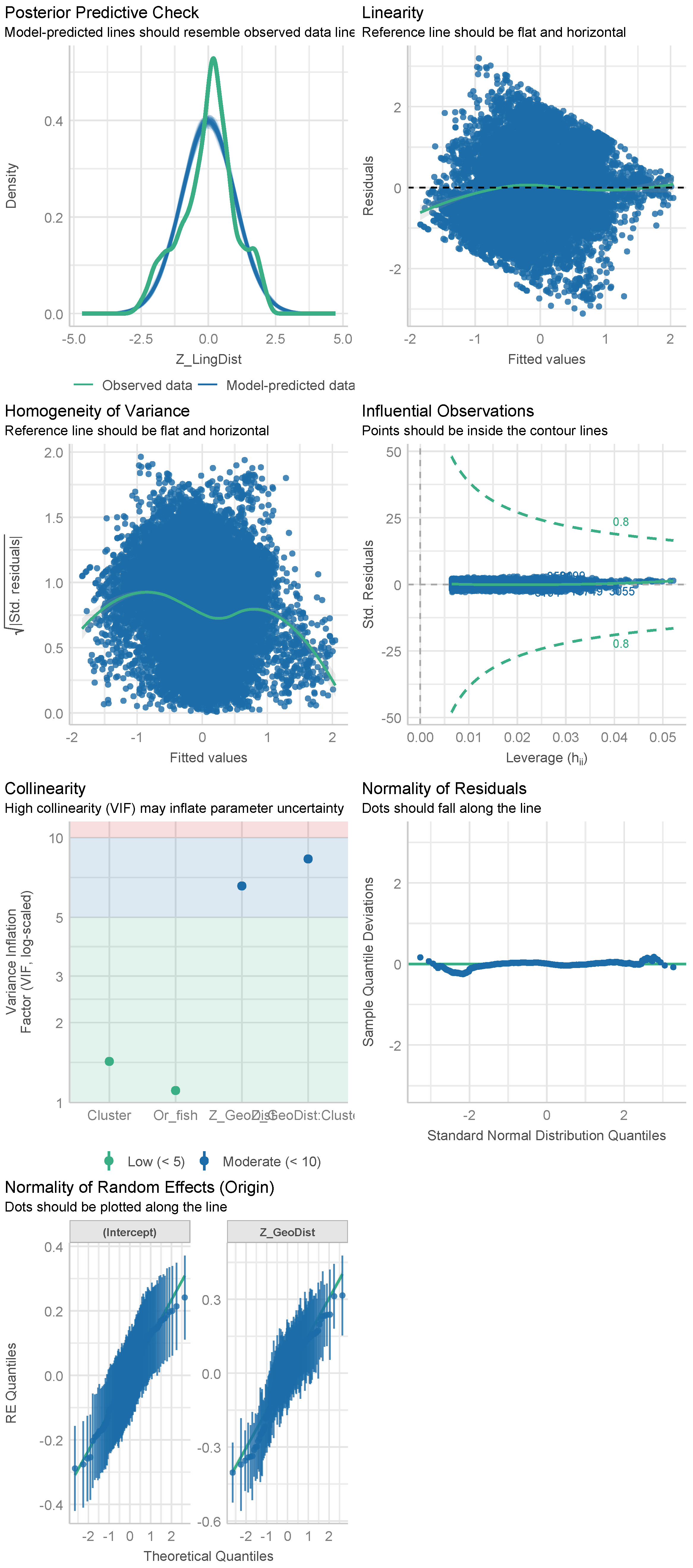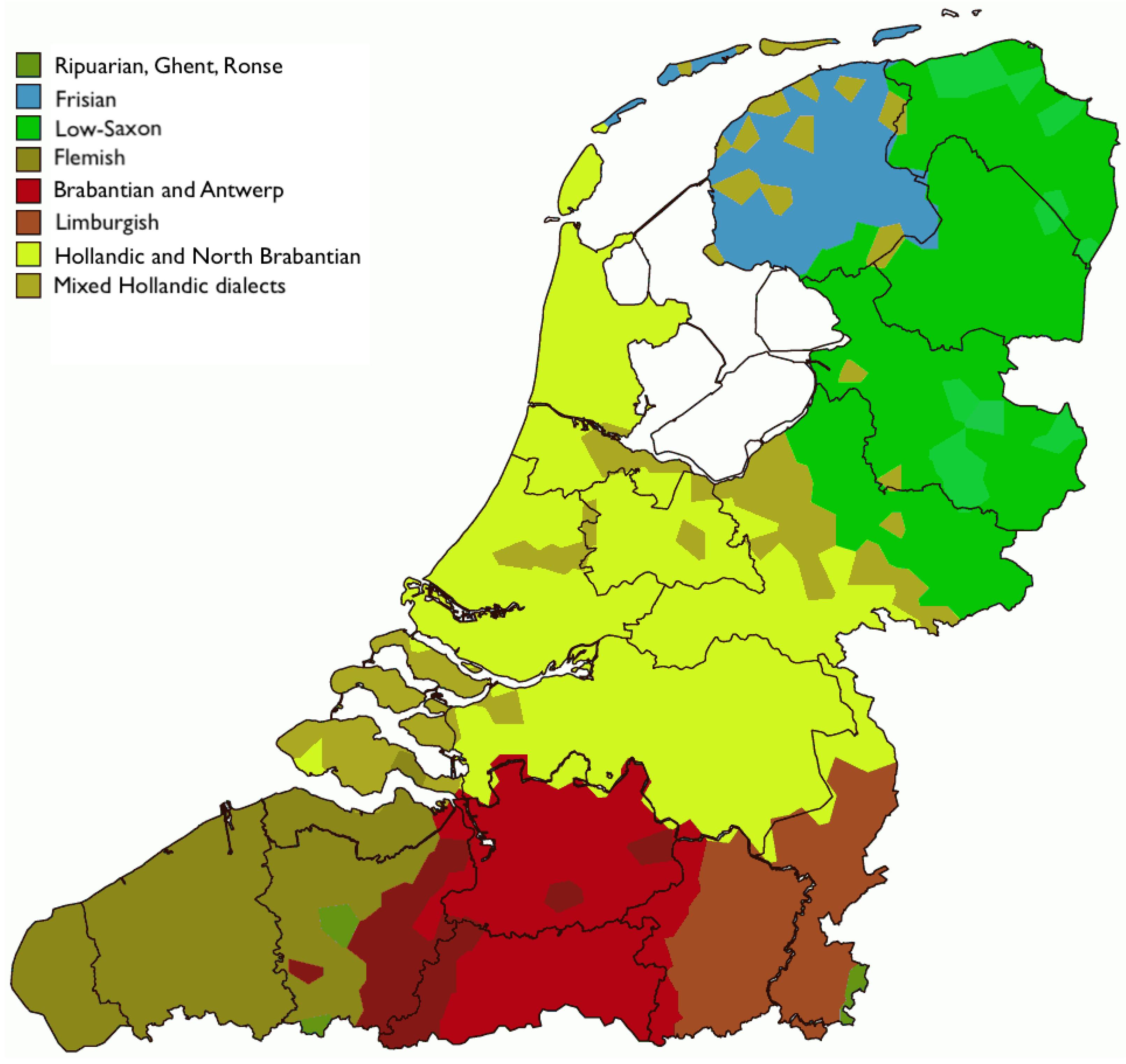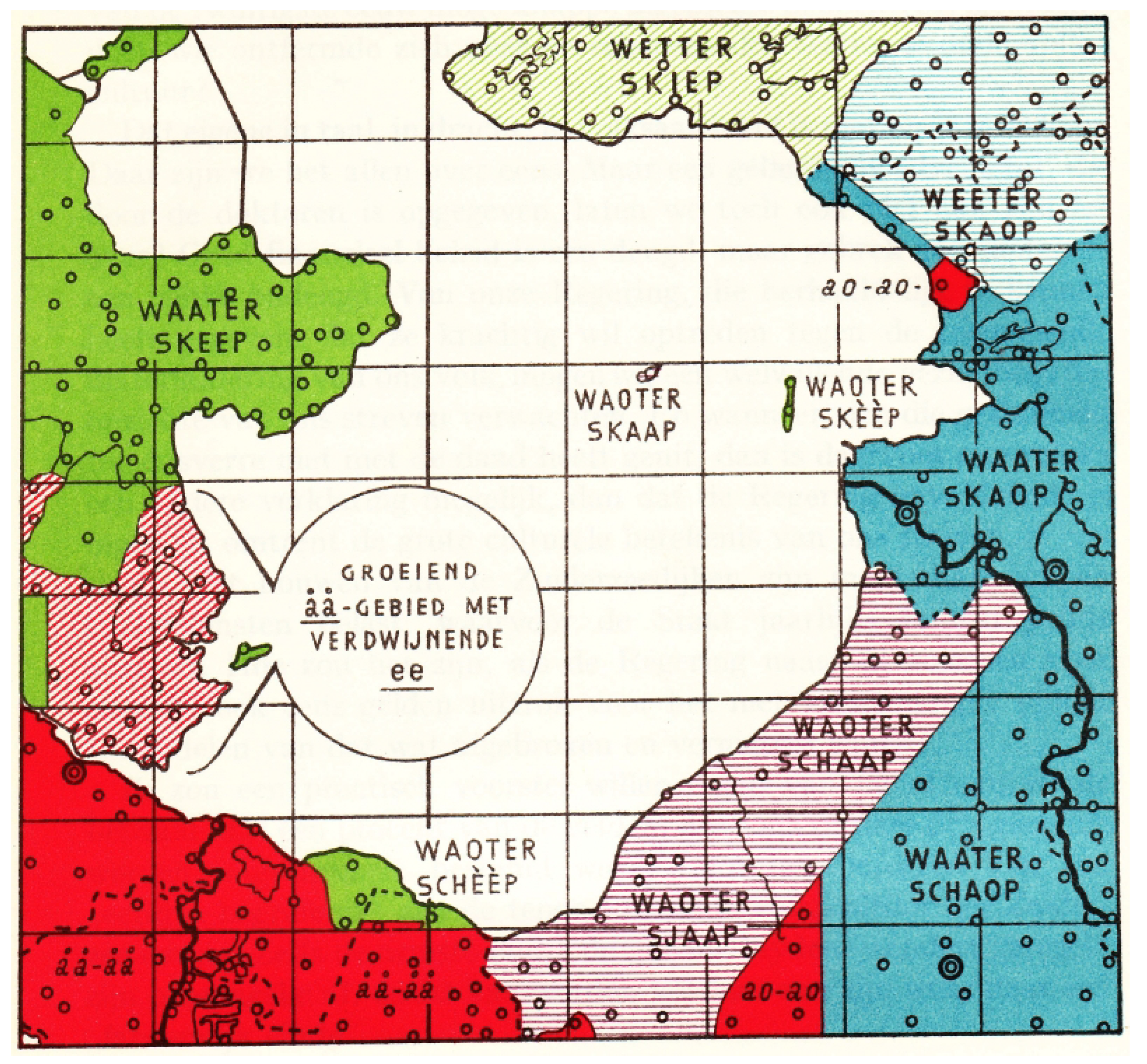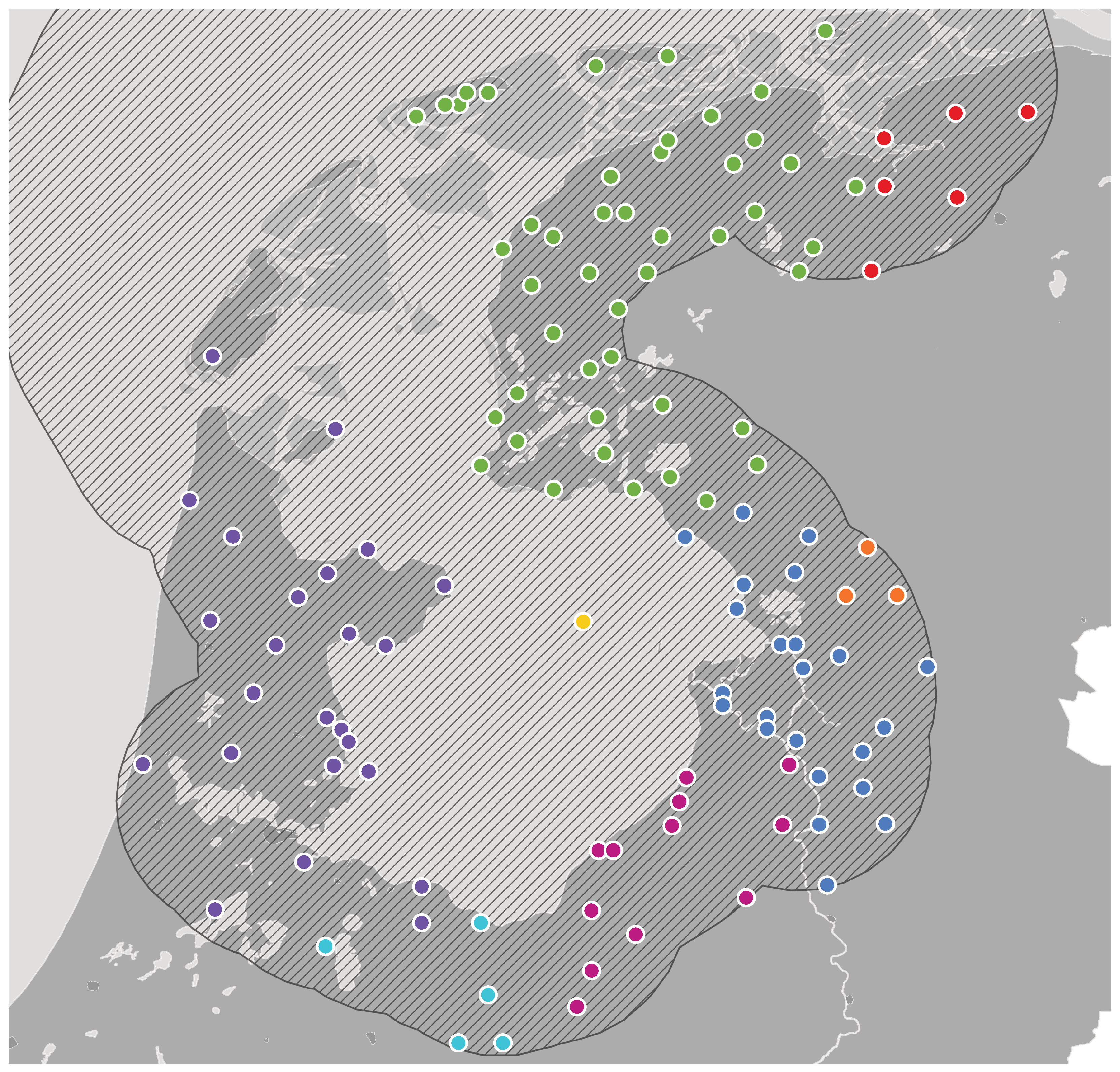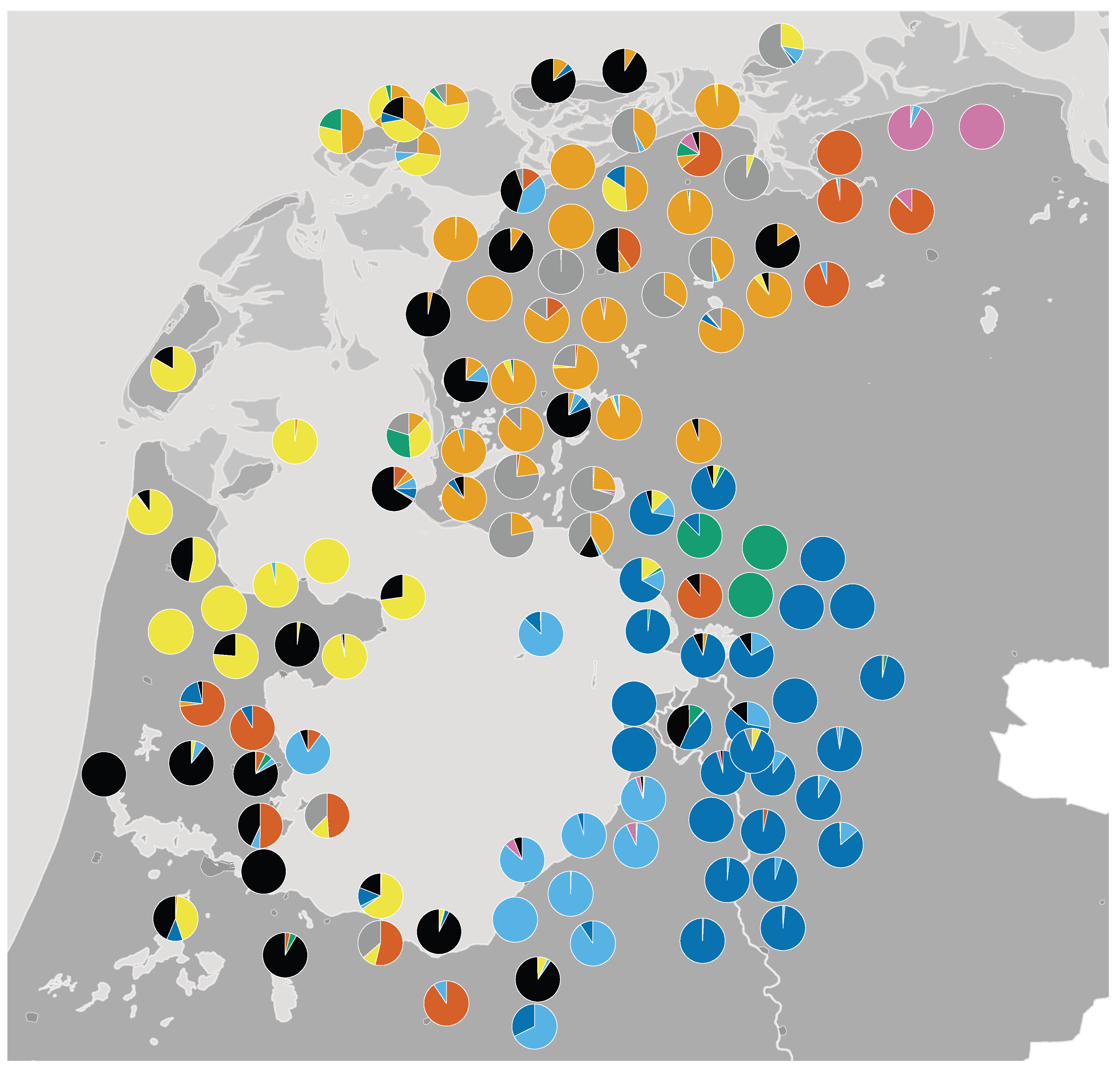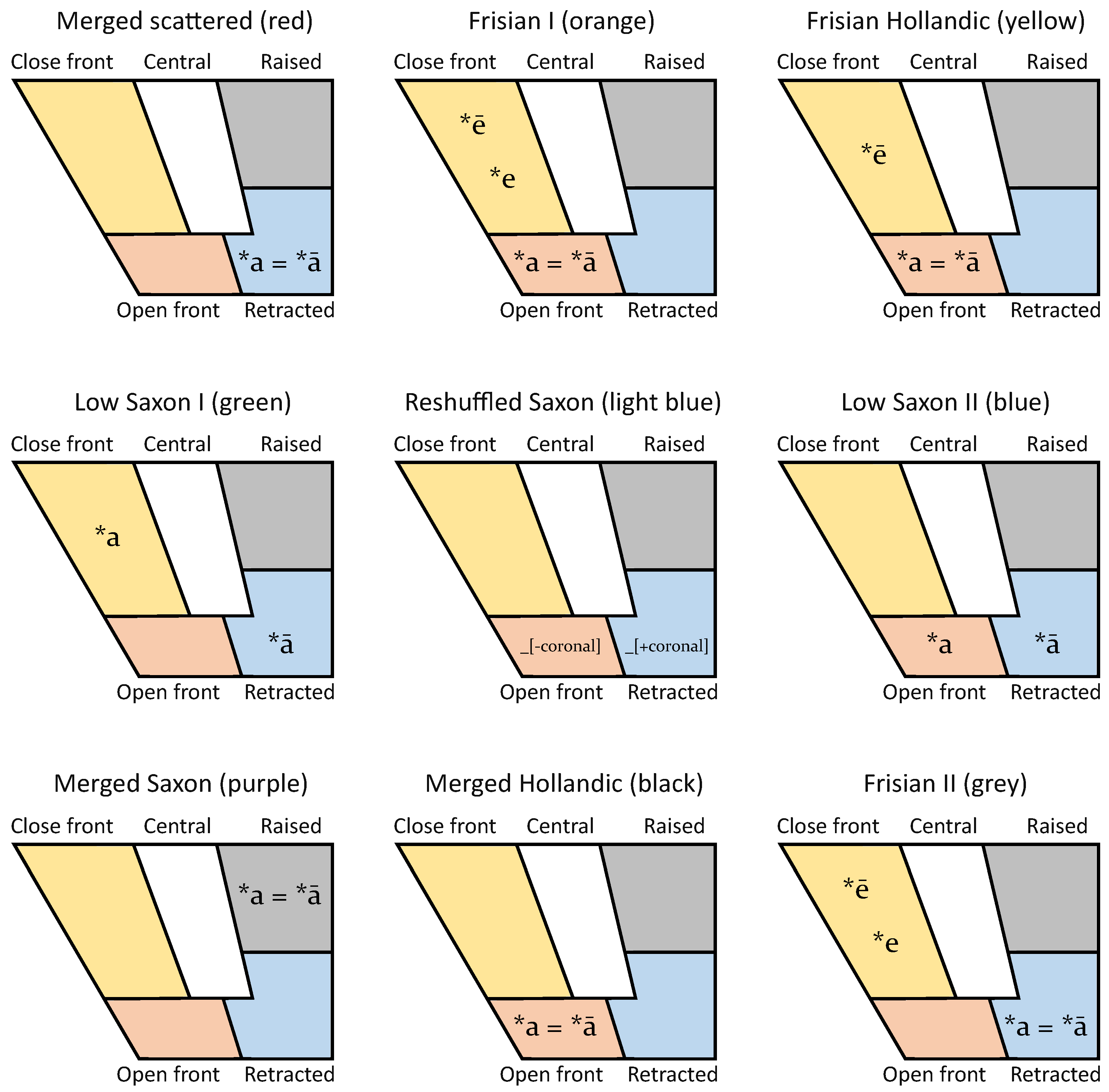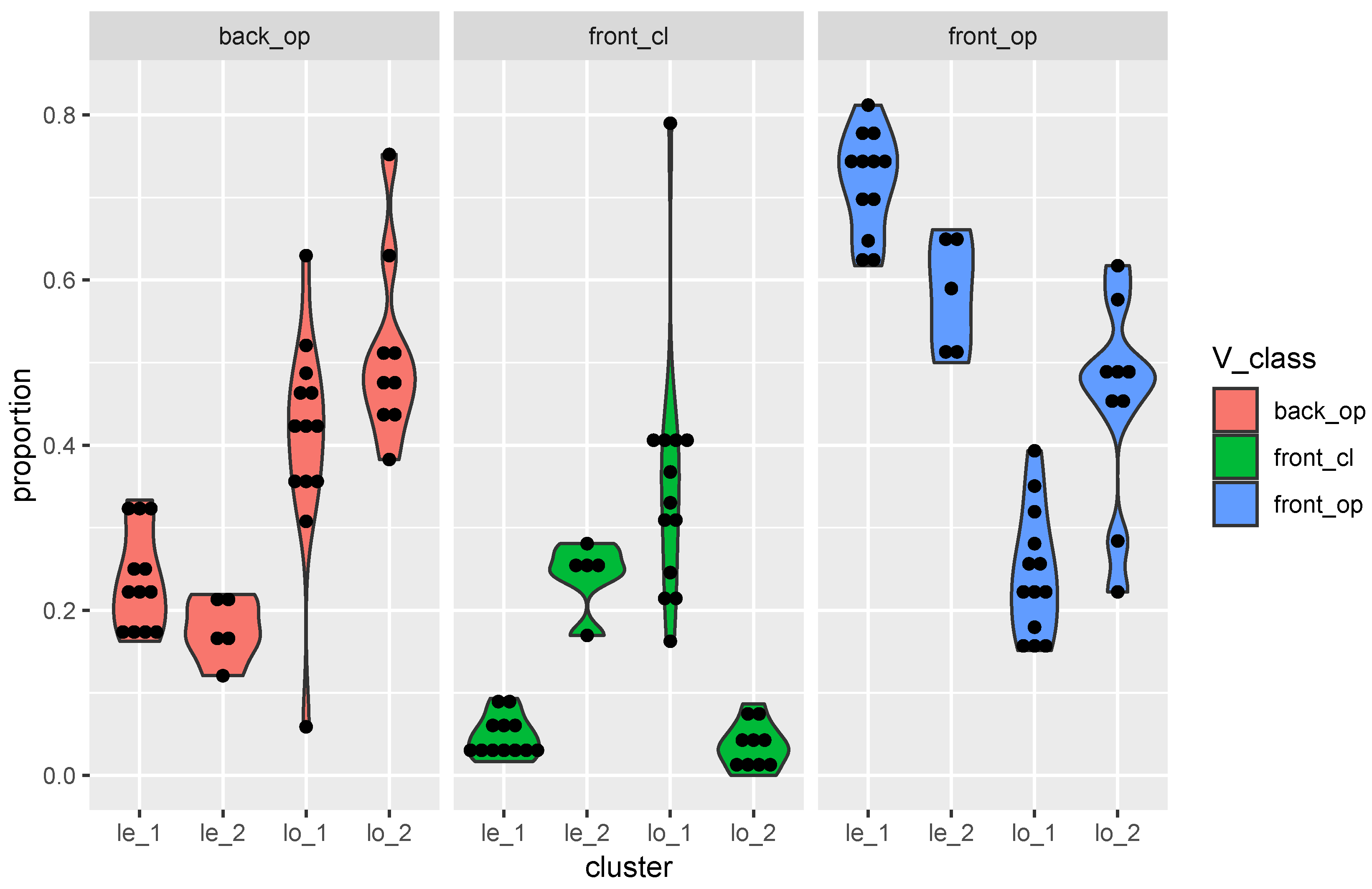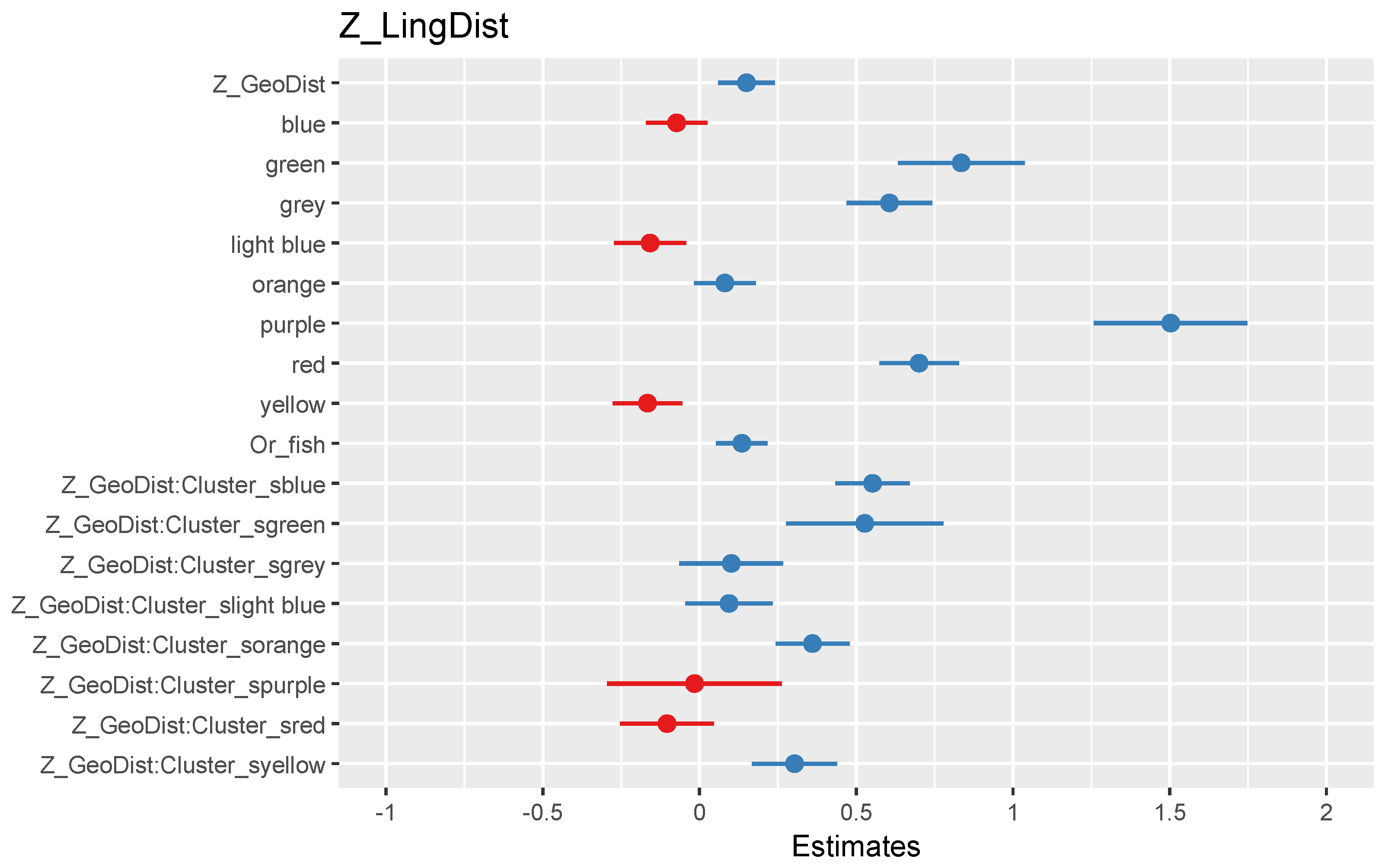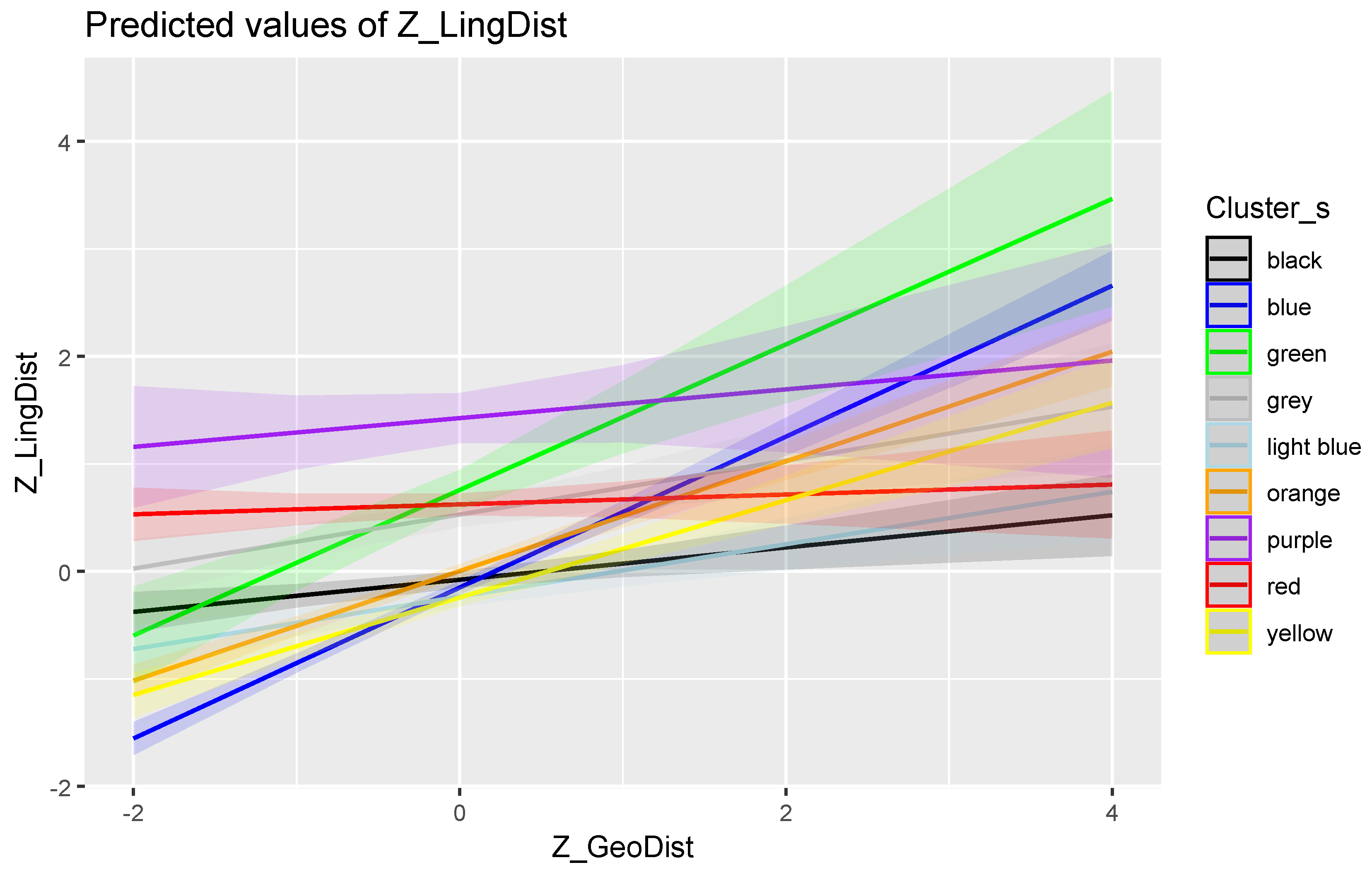1. Introduction
The former
Zuiderzee (‘Southern Sea’) area, nowadays called the
IJsselmeer, forms the old heart of the Netherlands. No other Dutch landscape has changed so drastically over the last century (
Nijboer, 2023). As the old heart of the Netherlands, the Zuiderzee offered a route for Hanseatic cities in the Middle Ages to trade with countries in the north and the east. Later, it became an intensive trade route for the rising Amsterdam in the sixteenth and seventeenth centuries. All ships coming from and going to Amsterdam sailed the Zuiderzee. The transformation of the
Zuiderzee was realised by the construction of the
Afsluitdijk between 1927 and 1932, a closure dam that definitively separated this inland sea from the incoming North Sea, protecting the hinterland against disastrous floods ever since. After the inland sea became a
meer (‘lake’), three large polders were created (the white areas in the map in
Figure 1).
Figure 1 outlines the main dialect areas in the Dutch language area, which covers all of the Netherlands and Flanders in Belgium. As the map shows, the former
Zuiderzee is at the crossroads of three regional language areas: Hollandish–Brabantish (in yellow, comprising the Hollandic and Brabantic dialects), Frisian (in blue, comprising the West Frisian dialects), and Low German (in green, comprising the Low Saxon dialects). These three language areas along with their dialects are geographically contiguous, except for the presence of various mixed dialects (in brown) that showcase the supra-regional influence of Hollandish. In addition to those dialects directly bordering the IJsselmeer, mixed Hollandish dialects are found in Friesland, e.g., in Stadsfries (‘Town Frisian’), which developed under Frisian influence in the Frisian localities with town privileges (cf.
Versloot, 2021). While Frisian (in blue) is nowadays restricted to just one province, the historical situation was different. In the Middle Ages, the Frisian language was spoken all along the North Sea coast. Over time, other languages replaced Frisian in some areas. The western parts of Frisia came under the supervision of the county of Holland in 1101, and the dominant language spoken in the north of this area became Dutch (Hollandish) with a Frisian substrate. In Groningen (the dark green area in the north-east of
Figure 1, right up to the blue Frisian (Fries) area) in the east, Low German (Low Saxon, in green) became the dominant language variety.
Dialectological research, notably by
Kloeke (
1934), has revealed complicated patterns of linguistic similarity across localities bordering the
Zuiderzee. He investigated the vowels in two words:
water (‘water’) and
schaap (‘sheep’). Their origins are different, the former descending from the Proto-West Germanic (PWGmc) short vowel *a (which was later lengthened) and the latter from the PWGmc long vowel *ā. The famous dialect map Kloeke made based on his investigation is reproduced in
Figure 2 (
Kloeke, 1934). Colours were added to visualise the different areas better. The map shows areas where the two vowels merged (as in Standard Dutch; in red) and areas where they were kept distinct (as in, e.g., English; in other colours). The merger between the two German vowels is a well-known development in Standard Dutch (
van Bree & Versloot, 2008). This merger is also found in the dialect of Amsterdam and in southern dialects, whereas Frisian and most dialects around the Zuiderzee kept the distinction in various ways (cf.
van Bree & Versloot, 2008;
Weijnen, 1966)
1, as illustrated in detail in the map by Kloeke we have reproduced (
Figure 2). The green areas have a close front vowel for ‘sheep’, whereas the blue areas have an open back vowel for ‘sheep’. Apart from the distinctiveness of Frisian (the only area with a close front vowel in ‘water’),
2 the patterns of the two vowels do not fully coincide with the dialect areas shown in
Figure 1. Overall, the map shows that the reflexes of the two words indicate complicated patterns of linguistic variation surrounding the
Zuiderzee.
The patterns of similarities and differences around the
Zuiderzee raise the question of how they came about. They seem to be more complicated than a straightforward distinction between the three language areas. What additional explanations, such as migration, diffusion, or contact over water, could be behind them? One interesting case is the former island of
Urk, for which the variants ‘WAOTER’ and ‘SKAAAP’ were observed. This pattern differs from the that of the nearest mainland localities in blue. Remarkably, the island to the right, Schokland, is green, while the mainland green area to the left is far away. This island was evacuated in 1859 and the population was relocated to various places around the Zuiderzee. One explanatory factor for this kind of variation could be the distinctive role of contact over water, which may have had a different or supplementary impact in addition to contact over land (
Huisman et al., 2019). Over land, interaction tends to be more intense due to a lack of natural barriers, leading to processes of linguistic diffusion over short distances. As a result, neighbouring dialects will differ only slightly (
Chambers & Trudgill, 1998). Contact between geographically distant communities will be less frequent, diffusion will occur less, and a dialect continuum will emerge.
Nerbonne (
2010) investigated language varieties in six areas (Bantu, Bulgaria, Germany, the US East Coast, the Netherlands, and Norway) and found that linguistic differences gradually increased over geographic distance.
What could be the role of an inland sea? The
Zuiderzee was a changing landscape during the last few centuries. Sustained contact between communities bordering the sea may have been difficult, blocking communication and separating the three regional language areas. This pattern is what we see in
Figure 2. On the other hand, there was a lot of ship traffic in this area, and the islands in its archipelago were not marked as being isolated from ship traffic and contact.
The general linguistic patterns across the Zuiderzee cannot easily be linked to other factors, such as the demography and genetics. Unlike linguistic variation, most major genetic (and, by extension, demographic) variation is observed along a north–south gradient (
Abdellaoui et al., 2013;
Francioli et al., 2014), broadly reflecting the division between Protestants and Catholics shaped by the major rivers. This division does not align with the traditional threefold linguistic division of Saxon, Frisian, and Hollandic. Recent work (
Byrne et al., 2020) confirmed the largely north–south nature of the genetic divisions in the Netherlands but nuanced it by uncovering subtle, more recent divisions along other axes—notably the east–west axis, which coincides very roughly with the linguistic difference between Hollandic and Saxon. The population of the Saxon regions comprises various separate genetic clusters, which indicate isolation. Nonetheless, this does not apply to Frisia, as Frisia genetically aligns with Holland and the northern part of Groningen. On the other hand, a few places in the Zuiderzee are characterised by a highly distinct genetic and demographic profile. The most telling example is Urk, which demonstrates extensive genetic homogeneity and isolation (
Somers et al., 2017). Additionally, other places such as Volendam and the former island of Schokland are known to have a presence of unique genetic disorders resulting from prolonged genetic isolation (
Madan et al., 1990). Genetic isolation seems—in these places—to coincide with linguistic distinctiveness.
We wanted to investigate the configuration of the language area around the
Zuiderzee by using more data than just the two particular words investigated by
Kloeke (
1934), as they represent two larger groups of words
3. The words selected for this study comprised various parts of speech (nouns, verbs, adjectives) and covered both basic vocabulary (e.g., ‘day’, ‘to sleep’, ‘heavy’) and cultural-specific concepts (e.g., ‘Easter’). The words in which the two vowels occur thus provide broad coverage of the lexicon, making them highly representative of the general underlying dynamics of dialectal change in the area. The vowels in these groups of words will likely vary across dialects depending on their etymological origin. Still, we also wanted to take into account their phonological context, as well as external factors like language contact (either through cultural diffusion or migration (cf.
Gerritsen & van Hout, 2006)). We used the GTPR (Goeman–Taeldeman–Van Reenen project;
Taeldeman & Goeman, 1996) database, available from Gabmap (
Nerbonne et al., 2011), to answer the following three research questions:
Which dialect groups can we distinguish based on the vowels in these two groups of words?
To what extent do these groups reflect cultural diffusion and migration across the three general regional language areas?
How can distance in general, and the distance over water in particular, help explain the geographic patterns in vowel variation?
To address the first and second research questions, we applied admixture analysis, a type of model-based clustering method originally developed in population genetics (
Patterson et al., 2006;
Pritchard et al., 2000). Its aim is to determine how individuals can be classified into populations. In a linguistic scenario, it has been used to classify languages into language (sub)families (
Norvik et al., 2022;
Reesink et al., 2009) or dialects into dialect groups (
Honkola et al., 2018;
Syrjänen et al., 2016). The method infers
k ancestral populations (here, dialect groups) and models the ancestry of each individual (here, each dialect). Crucially, it allows individuals to have multiple ancestors, i.e., they can be admixtures of multiple populations. Linguistic admixture can be regarded as contact patterns between languages/dialects, thus making this approach a suitable choice for the current study.
Admixture analysis shows which clusters of localities can be distinguished and how typical dialects (individuals) are for these clusters (dialect groups, populations) or how mixed they are. We related the clusters to typical examples of words, but that excluded the mixed dialects. Our next step was to investigate the similarities between the words we selected to obtain more insight into the genetic (linguistic) material. We applied hierarchical cluster analysis to investigate whether all words were really classified as expected on the basis of their historical origin—specific words may have their own, deviant pattern—or whether the distribution of the vowels took a different course. We used the outcomes of this cluster analysis to compute the linguistic distances between the dialects to answer the third research question.
To answer the third research question, we performed a mixed-effects regression analysis, in which we included both the clusters found and the linguistic and geographic distances between the locations involved. This analysis should provide insight into the role of the distance over land and water and geographical clustering (
Huisman et al., 2019).
The peculiar situation of the
Zuiderzee is (at least partially) reflected in the genetic structure of the Dutch population and the population admixtures around the Southern Sea (
Byrne et al., 2020). We focused on the dialect data, of course, and the resulting clusters. To address the second research question, we needed to compare the outcomes to the dialect areas distinguished in the maps in
Figure 1 and
Figure 2. We hoped to show that admixture analysis contributes to the detection of the different sources (ancestors, migration) of dialect differences and areal differentiation and to test the role of linguistic parameters.
3. Results
3.1. Admixture Analysis: Nine Clusters
The outcome of the admixture analysis with
k = 9 is shown in the map in
Figure 5. Each pie chart represents a dialect coloured according to its admixture coefficients (using nine different colours for the nine inferred ancestral populations). If a pie chart only has one colour, this means that this dialect was inferred to have descended from just one of the nine ancestral populations. As the map shows, there was at least one such dialect for each of the nine clusters. If a pie chart has multiple colours, this means the admixture analysis inferred the dialect to be an admixture of two or more ancestral populations. Overall, the results suggested that there were more dialects with some admixture than dialects without any admixture. This was as expected, given the rich history of traffic and contact across this linguistic area.
As is clear from the map, the clusters inferred from the admixture analysis were geographically contiguous and fit earlier typologies of the dialects in the
Zuiderzee area. As such, we have tried to name them accordingly in our description (see also
Table 2).
To further interpret the linguistic features underlying the nine clusters, we selected dialects whose admixture coefficient was higher than 0.75 for each respective cluster and qualitatively investigated the vowel classes across different groups of words. The outcome is summarised in
Figure 6. These coefficients vary between 0.00 and 1.00. A value of 0.75 indicates that the majority of an individual’s ancestry comes from a single ancestral population. This threshold has been used in a comparable study on Finnish (REF). In our case, almost all the locations (109 out of the 121 locations) had one ancestry component at 0.75 or higher. The vowel panels show how the different Proto-West Germanic vowels were realised across the nine inferred clusters.
The clusters inferred from the admixture analysis can broadly be categorised into three distinct realisation patterns for the Proto-West Germanic (PWGmc) vowels: (1) a Frisian type, with traces of the Old Frisian *e/*ē; (2) a Saxon type, with distinct vowels for *a and *ā; and (3) a merged type, with a single vowel for *a and *ā.
The Frisian I (orange), Frisian II (grey), and Frisian Hollandic (yellow) clusters all displayed a pattern in which we found close front vowels in some, but not all, words where the PWGmc *a/*ā had already been raised to *e/*ē in Old Frisian (OFr)
4. These data suggest that OFr *e and *ē are kept distinct in most contemporary dialects (as two different close front vowels). Still, the number of items is too limited to draw definite conclusions. At the same time, all three groups had a merged OFr *a and *ā, but with some differences in their realisation: an open front vowel in the orange and yellow clusters and a retracted vowel in the grey cluster. Geographically, these dialects were found where one would expect them: members of the Frisian I and II groups were found on the mainland of Friesland and on the island of
Schiermonnikoog, where a highly distinctive Frisian dialect is spoken. Members of the Frisian Hollandic group were found in the adjacent coastal areas in the west, including the islands of Texel and Terschelling.
The Low Saxon I (green) and Low Saxon II (dark blue) clusters comprised dialects where the PWGmc *a and *ā were kept distinct. Both groups realised *ā as a retracted vowel, but they differed in their realisation of *a: close front in the Low Saxon I group and open front in the Low Saxon II group. A third cluster that could be considered part of this pattern was named Reshuffled Saxon (light blue). Here, we found two realisations of *a and *ā, but not along the lines of the PWGmc categories. Instead, a new distinction appears to have developed here, where *a/*ā is realised as a retracted vowel when followed by a coronal consonant but as a front vowel when followed by other consonants. Members of all three groups were found on the east side of the Zuiderzee (including Urk), with the notable exception of Volendam in the west. Low Saxon I (green) can be seen as a subgroup of the Low Saxon II group, as its size and spread are considerably smaller.
The dialects assigned to the remaining three clusters had a merged PWGmc *ā and *a (as in Standard Dutch). In the Merged Hollandic cluster (black), the merged vowel category was realised as an open front vowel. Dialects belonging to this group were mostly found in the west, but they also included the Town Frisian dialects (known for their Hollandic influence) and the island of Ameland, which had a large influx of Hollandic-speaking shipping crew. The Merged Saxon cluster (purple) was found in the north-east and showed a distinctive raised vowel. Finally, we named the red cluster Merged Scattered, as its members were geographically scattered. The groups comprised both Hollandic and Saxon lects in which the merged *a/*ā category was realised as a back vowel. A closer inspection of the data revealed that the vowel quality differed according to the region (/ɒ/) in the western region, /ɑ/ in the middle region, and /ɔ/ in the north-eastern region), which suggests that their grouping was in part due to recoding the vowels into five broader classes.
Figure 6 and
Figure 7 summarise the vowel realisations, split by their etymological origin, across the nine clusters, as well as exemplars for eight different word classes from a typical member of each group.
3.2. Admixture Across Fishing vs. Non-Fishing Villages
As
Figure 3 shows, there was some variation in the admixture level inferred for each dialect. Some dialects were assigned to just one ancestral population, whereas others were assigned to two or three (or even more) ancestral populations with different ratios. If we see admixture as the result of contact between dialects, a dialect with zero admixture can be seen as a ‘pure’ descendant of an ancestral population. On the other hand, dialects that show some level of admixture can be seen as dialects in which some outside influence is evident. In the current linguistic area, we expected a difference between fishing and non-fishing villages. Fishing villages can be expected to show higher levels of contact—i.e., admixture—due to increased interaction with their fellow fishing localities. We squared each admixture coefficient to quantify this, summed the squares, and subtracted the sum from 1. This overall admixture score is akin to many diversity/differentiation indices developed in various fields. The measure was 0 if a dialect was assigned to just one ancestral population and maximal if it was assigned to all nine ancestral populations in equal proportions. While the average admixture score for fishing villages (
) was higher than for non-fishing villages (
), this difference was not significant (
,
p = 0.066, Cohen’s
).
3.3. Variation Between Words and Word Clusters
We applied a hierarchical cluster analysis (SPSS, Ward’s method, chi-square distance) to the words, applied to the frequencies of the three most frequent vowel classes. The input for the analysis was the vowel value for 40 words for 121 places, obtained by counting their frequencies. We analysed the clustering in the words. We omitted the central vowel class and the raised retracted vowel class (see
Figure 4), which both had an extremely low frequency (respectively,
n = 43.1% of all occurrences and
n = 88.2% of all occurrences). They did not have a relevant effect on the outcomes of the cluster analysis. The result was four clusters, nicely split up between words descending from the PWGmc short *a and long *ā forms on the one hand and words that were or were not affected by Anglo-Frisian brightening on the other. The main mismatch here was
traag (‘slow’), which was grouped together with other short-vowel words, even though it is descended from a form with a long vowel (*trāgi).
We visualised in
Figure 8 the differences between the clusters in violin plots. Clusters 3 (le_1) and 4 (le_2) behaved similarly in terms of having many front–open occurrences, but cluster 3 had the most front–open realisations. Anglo-Frisian brightening (see Note 2) was visible in cluster 2, lo_2, having the consequence that this cluster had more front–open realisations than cluster 1, lo_1. The last two clusters, 1 and 2, had more back realisations. There was one cluster or class shift, the word
traag, which shifted from cluster 1 to 3.
In general, we saw that the four clusters described in
Table 3 behaved distinctively, but it was also clear that there was a considerable amount of variation even within those clusters. This word-specific variation was reflected in the relatively high level of admixture found for many localities. This indicates that several processes were active, including levelling effects from Hollandish and Standard Dutch influences. It also seems to reveal that contacts and traffic were important in this area.
3.4. Mixed Regression and Distances
The admixture analysis revealed nine dialect clusters across the three regional language areas around the
Zuiderzee. Their characteristics were a combination of historical processes (descent from Proto-West Germanic) and linguistic restructuring (e.g., the coronal distinction in the Reshuffled Saxon cluster), as well as dialect levelling (the disappearance of any distinction) due to, e.g., standard language influence. At the same time, we observed that several clusters were rather scattered, whereas others were more contiguous. What additional explanatory power does geographic distance have for this clustering? We decided to use a matrix mixed-effect regression, as explained and tested in
Huisman and van Hout (
2023).
The first issue to deal with was how to measure the geographic distance. Which traffic routes brought people in contact with each other, and how were they travelling? How much time did this travelling take? These are fundamental questions, but hard to answer. Given the lack of adequate historical sources that take all these factors into account, we measured the geographic distance in the simplest way possible: as the crow flies. We did not consider old or existing traffic routes, nor did we distinguish between travel over water vs. travel over land. In addition, no specific barriers needed to be taken into account for this area. We will return to the appropriateness of this approach in the Discussion.
The next issue was how to measure the linguistic distance. We operationalised this using the four groups of words shown in
Table 3 and the relative frequencies of vowel classes across these groups (see
Figure 8 for a general overview). For each locality, we determined, for each of the four word groups, the frequency of occurrence of the four vowel categories (close front, open front, open back, and closed back). Then, for each pair of localities, we used these counts to compute, for each word group, the chi-square value. Finally, we calculated the sum of the four chi-square values (one for each word group) as a measure of the overall linguistic distance between a pair of localities.
5Having determined the geographic and linguistic distances between all pairs of localities, we plotted their relation, shown in
Figure 9. The figure is a scattergram of the linguistic distance over the geographic distance, with a Loess smooth line added to visualise the pattern of covariation.
Figure 9 shows, overall, that the linguistic distance increased with an increasing geographic distance. This pattern is often found for dialects and is typical of a dialect continuum (
Nerbonne, 2010). The correlation between the two measures was 0.366, which can qualify as moderate, meaning there was a considerable number of observations that deviated from the linear pattern. While there were few cases where we found small linguistic distances between pairs of localities that were far apart, we found many pairs of localities that were close to each other but which showed large linguistic distances.
Next, we investigated whether this relationship between the linguistic and geographic distances was the same across the nine clusters. To do so, we assigned each locality to a specific cluster based on its highest admixture coefficient.
Figure 10 shows a scattergram with a Loess-smoothed line for each of the nine clusters.
The figure shows some obvious differences between the clusters. The yellow (Frisian Hollandish) and green (Low Saxon I) clusters show a clear, steadily increasing pattern. Several clusters show a plateauing of the linguistic distance (e.g., the Frisian orange and grey clusters). Finally, the clusters comprising dialects in which the two PWGmc vowels were merged (black, red, and purple), show a largely flat line, indicating the absence of a relationship.
To examine the relation between the linguistic and geographic distance in detail, we applied linear mixed-effects regression analysis (lme4 package (
Bates et al., 2015) in R), using the full pairwise distance matrices as explained and tested in
Huisman and van Hout (
2023). In this approach, each locality was compared to every other locality, with a random effect for the reference locality to account for the linguistic uniqueness of each dialect. When we omitted self-comparisons, each of the 121 localities was compared to the other 120 localities, producing a matrix of
= 14,520 rows.
The predictor variables for the linguistic distance were (1) the geographic distance
6, (2) dialect cluster membership of the reference locality (nine categories), and (3) whether the locality was a fishing locality (binary yes/no), both for the reference locality and the comparison locality. We added these two variables to test whether fishing localities in the
Zuiderzee had a special position. All continuous variables were normalised. We checked the regression assumptions using
check_model, a tool that is available in the performance package (
Lüdecke et al., 2021). There were no violations. The outcomes can be found in
Appendix C.
We selected the best-performing model based on the AIC. This model contained the main effects of the geographic distance, dialect cluster membership, and the interaction between the two. In addition, there was a main effect of the fishing locality status for the reference locality. There was a random effect for the reference locality as an intercept, plus a slope for the geographical distance for the reference locality. We also investigated whether a non-linear model performed better, but transformations or polytomous models provided no improvement. We have summarised the outcomes in a table in
Appendix B and in
Figure 11, which visualises the effect sizes (determined, respectively, by the
tab_model and
plot_model functions from the package sjPlot (
Lüdecke, 2023)).
Figure 11 gives a positive main effect for Z_GeoDist, that is, the normalised value of the geographic distance. There was also a positive main effect of the fishing locality status. There were many effects of the clusters and their interaction with the geographic distance. The reference point for their values was the black cluster. These effects are visualised in
Figure 12 and
Figure 13, along with results from
plot_model.
The two Low Saxon clusters (dark blue and green) in
Figure 12 show strongly increasing lines, and both have low values for nearby localities, indicating that both clusters are contiguous. The orange and yellow clusters also have a line that is clearly going up. The grey cluster is more scattered, without a contiguous territory. The consequence is a flatter relationship with the distance. The four remaining lines all go up, but their pattern is more flat. The light blue Saxon cluster is scattered in the south part of the
Zuiderzee, with the fishing localities of
Volendam and
Urk as the most conspicuous localities.
The purple, red, and black lines represent merged vowels. The red and black clusters seem to show Hollandish influence. The black cluster in particular illustrates the far-reaching influence of Hollandish, in combination with the dominant position of the Dutch standard language in general. The black cluster shows the impact of expansion and diffusion in a larger area.
Figure 13 confirms the height of the interaction lines’ slopes. The
x axis was switched and now represents the nine clusters. The distance between the blue and black spots represents the size of the slope. Moreover, the confidence intervals turned out to be larger for larger distances (the blue spots). There was more variation in the linguistic distance when the geographic distances were larger.
Why was the fishing locality origin significant and not the interaction concerning whether the other locality was a fishing village or not? Such an interaction would have suggested that fishing localities were more alike (compare Volendam and Urk), but that was not what we found as a general effect. We found an additional distance effect, meaning the effect of the distance from other villages was even a bit stronger. Perhaps this indicates their special character. Despite their many contacts, they were closed communities as well.
A last point is the explained variance: the marginal = 0.282 and conditional = 0.338. Both values show that a substantial part of the differences remains unexplained, as indicated by the size of the residual variance.
4. Discussion
In this contribution, we investigated a long-standing issue in Dutch dialectology, the distinction in vowel pronunciation between water, ‘water’, and schaap, ‘sheep’, and its geographic distribution over the Zuiderzee dialects. These two vowels merged in standard Dutch. Originally, their vowels had two different West Germanic ancestors. We extended the analysis to two larger sets of words that we could investigate in an extensive dialect database, the GTRP. We had many representatives of these two ancestor vowel classes, although the word water was missing. The effects of Frisian fronting (Anglo-Frisian brightening) complicated this binary distinction in both vowel classes. In fact, we had to deal with four word classes or clusters.
We applied several dialectometric techniques to unravel the dialect–geographic distribution patterns of the words involved, focalising on their nucleus vowel. We started with the admixture analysis. We obtained nine clusters, with many localities having a mixed pattern of clusters. These mixtures demonstrate the intensive contact between areas and localities. We also applied a hierarchical cluster analysis to the words and completed the analysis with a mixed regression analysis to reveal the interaction of the linguistic and geographic distance in relation to the nine clusters we found. We applied these techniques successfully to obtain an answer to our three research questions:
Which dialect groups can we distinguish based on the vowels in these two groups of words?
To what extent do these groups reflect cultural diffusion and migration across the three general language areas?
How can distance in general, and the distance over water in particular, help explain the geographic patterns in vowel variation?
Three regional language areas, Hollandish (in fact, Hollandish–Brabantish; see
Figure 1), Frisian, and Saxon, surround the area of investigation, the old inland sea of the
Zuiderzee, in combination with spots and areas with mixed dialects. We found nine clusters. We could assign the clusters to three larger categories: Frisian, Saxon, and merged dialects, including the black Hollandish pattern. We found a Frisian substrate (yellow) in the Hollandic area and a clear Hollandic influence in Friesland and on the island of Ameland. A remarkable Frisian pattern was found for Hindeloopen, in the lower part of Frisia, bordering the
Zuiderzee. Its circle contained all three Frisian colours, plus a green Saxon part.
van Ginneken (
1928) mentions Hindeloopen as a particular dialect and connects its conservative, old Frisian features with its special history going back to the Middle Ages, when the much smaller
Flevomeer (
meer = ‘lake’) preceded the later
Zuiderzee. The red circles were the most scattered cluster. In Groningen, they were neighbours of the small purple cluster. In both the red and purple clusters, the PWGmc vowels *a and *ā merged. We need to investigate the Groningen dialect area in more detail to find out if this merger is typical of the whole north-east region or whether there has been Hollandic influence. The red in the left part of the
Zuiderzee area neighbours the black cluster, the difference being the low front vs. back pronunciation of the merged vowel. The answer to research question 1 is that the nine clusters reflect the overall dialect structure of the three regional languages around the old
Zuiderzee area, with many traces of mixing, with Hollandish acting as a superstrate language overall, but especially in Frisia, and with Frisian as a substrate language in the Hollandic area.
Nevertheless, both
Kloeke (
1934) and
van Ginneken (
1928) emphasised the linguistic unity of the
Zuiderzee area.
van Ginneken (
1928) went far back in time to define a contiguous linguistic area. Following
Winkler (
1874), he presumed that the non-Frisian
Zuiderzee parts shared a common regional ancestor language, which he called
Flevisch, Flevish, that preceded the regional Hollandish and Saxon languages. He mentioned the island of Urk (largely light blue) as the best example of this ancestor language but also referred to the islands of
Texel (largely yellow) and
Terschelling (largely yellow). Only
Urk has the coronal split instead of the PWGmc *a/*ā distinction. Van Ginneken had already mentioned this split (
van Ginneken, 1928, p. 61). On the other hand, the light blue area coincides with the mixed dialect area of the map in
Figure 1, indicating that this is probably a more recent development and not a trace of a forgotten past.
Kloeke (
1934) was interested in the role of cultural expansion. He was interested in the role of Holland, in particular Amsterdam, as the main economic and cultural factor in inducing waves of linguistic diffusion over its surrounding area. The distribution of the black circles corroborates the strong role of expansion, migration, and diffusion, but they have not lead to a common language variety on the shores of the
Zuiderzee. There are many traces of traffic and contact given the many mixed patterns in the
Zuiderzee localities. The Amsterdam spheres of power were not strong enough to create a contiguous areal string of dialects bordering the
Zuiderzee. Both
Kloeke (
1934) and
van Ginneken (
1928) did not succeed in finding the common language variety they were looking for.
While the data available demonstrate that linguistic patterns are not necessarily or directly linked to broader demographic and genetic patterns, the presence of genetic similarities between Frisia and Holland could be seen to support the intensive contact between regions around the Zuiderzee and, hence, linguistic contact.
The role of geographic distance is visible in all dialectometric studies, but we have shown an additional possibility: estimating its exact effect, in hard figures. Can distance, in general, help explain the geographic patterns in vowel variation? We defined the distance as the crow flies, both in passing over the mainland and water. We defined the linguistic distance on the basis of four word sets and the frequency of vowel classes used in these four sets. We found an overall distance effect in the whole dataset, but this effect turned out to vary according to the cluster involved. Flat distance effects were found for the three clusters with merged vowels (purple, red, and black). The black and red clusters were too scattered to exhibit a clear distance effect. Interestingly, a small distance effect was found for the light blue cluster with two conspicuous fishing localities,
Volendam and
Urk. It seems to show that water may have a special influence specific to the dialects involved, but we found no overall effect of water. First of all, we found only an increasing linguistic distance effect for fishing localities, which was small. We found no effect of the overall linguistic distance between fishing localities. Secondly, we applied additional distance analyses, the most relevant one being the analysis where we used both the distance over land and the distance over water. This mixed distance model did not improve the results, meaning that the distance over water is the same as the distance over land, although the distances between localities over water were larger than over land. It is tempting to speculate that the travel time over water was comparable to the travel time over land on foot in older times. Water can be a blocking factor when the distances are large: island languages display a typical isolation pattern due to the geographic isolation of islands (
Huisman et al., 2019). The distances over water in the Zuiderzee were large enough to maintain the existence of three regional languages despite the combined influx of Hollandish and the Dutch standard language. This means that we can answer research question 3. The overall distance helped us to explain the geographic patterns of vowel variation in the
Zuiderzee area. The distance over water was included and was as effective as the distance over land. We expect this to be common in areas with a history of intensive and sustained shipping traffic. Water might be a building block in defining a dialect continuum.
We applied admixture analysis to vowel class data for two groups of words: the descendants of words with PWGmc *ā and the descendants of words with PWGmc *a. Within each group, it was inevitable that the historical developments of these vowels would be correlated to some degree, irrespective of whether the sound changes came from articulatory drift or from lexical diffusion. While there is undoubtedly some dependency on biology as well, admixture analysis based on genetic data assumes the variation that occurs across genes to be independent. Previous linguistic studies have tried to address this by selecting (e.g., typological) features that are less likely to be dependent on each other (e.g.,
Norvik et al., 2022;
Reesink et al., 2009). Here, we have chosen a different approach, selecting data based on their relevance to established work (e.g.,
Kloeke, 1934). Our analysis of the word groups (
Section 3.3) showed that they were far from uniform, suggesting that complete interrelatedness is not an issue here. However, future studies should evaluate our findings on contact patterns across the Zuiderzee using different—more independent—linguistic data.
How successful was our mixed regression analysis in terms of the explained variance? We reported a marginal of 0.282 and a conditional of 0.338. We are satisfied, given the remaining differences between the localities. We performed supplementary analyses, but there were no really outlying places. That does not preclude that local dialects can have their own developments and that localities may be or remain fairly isolated, in contact and in culture. This can be investigated in future research. The same applies to the individual words. There was still a lot of variation between the words, and the words may even betray their origin (cf. the word traag). This fits an old maxim in dialectology: each word has its own history.
